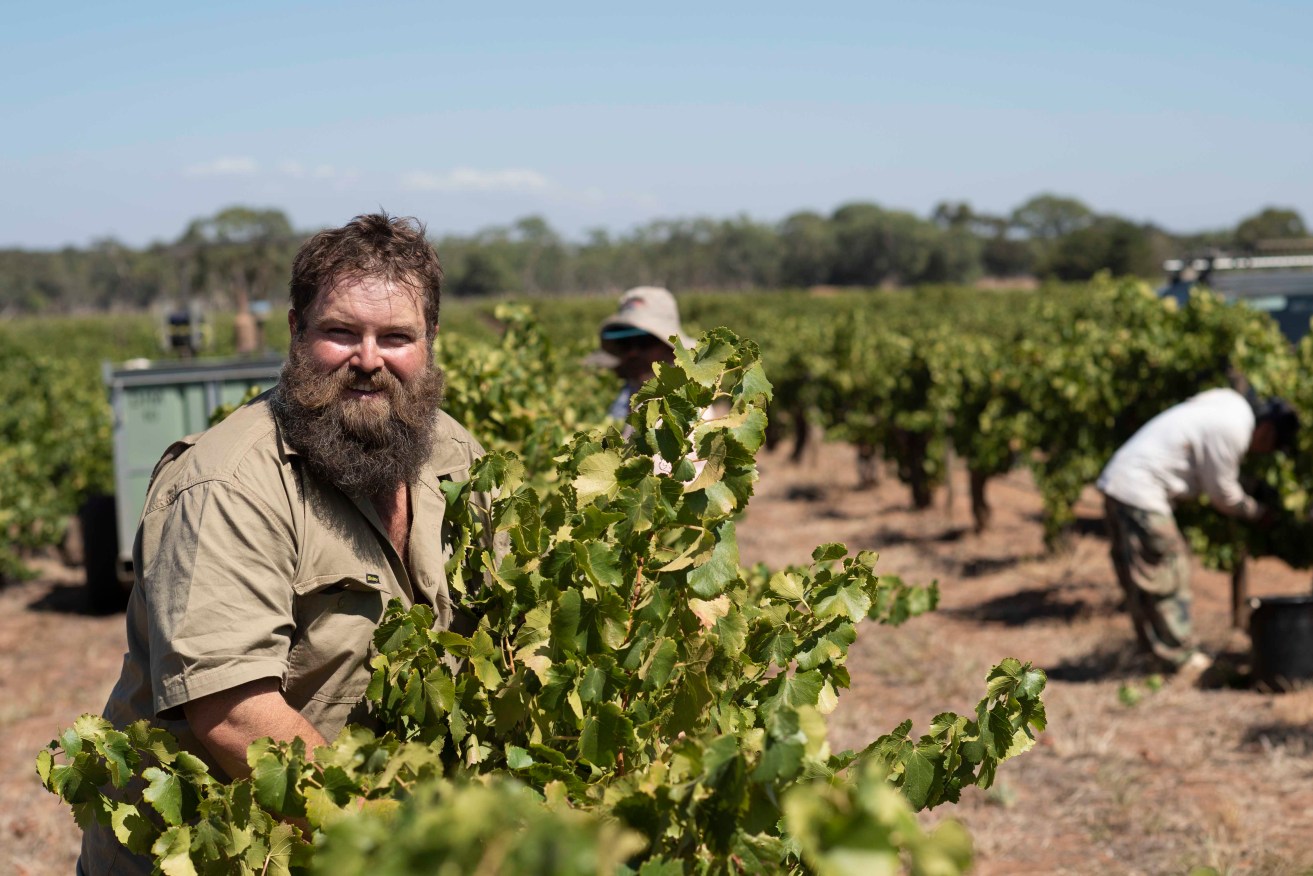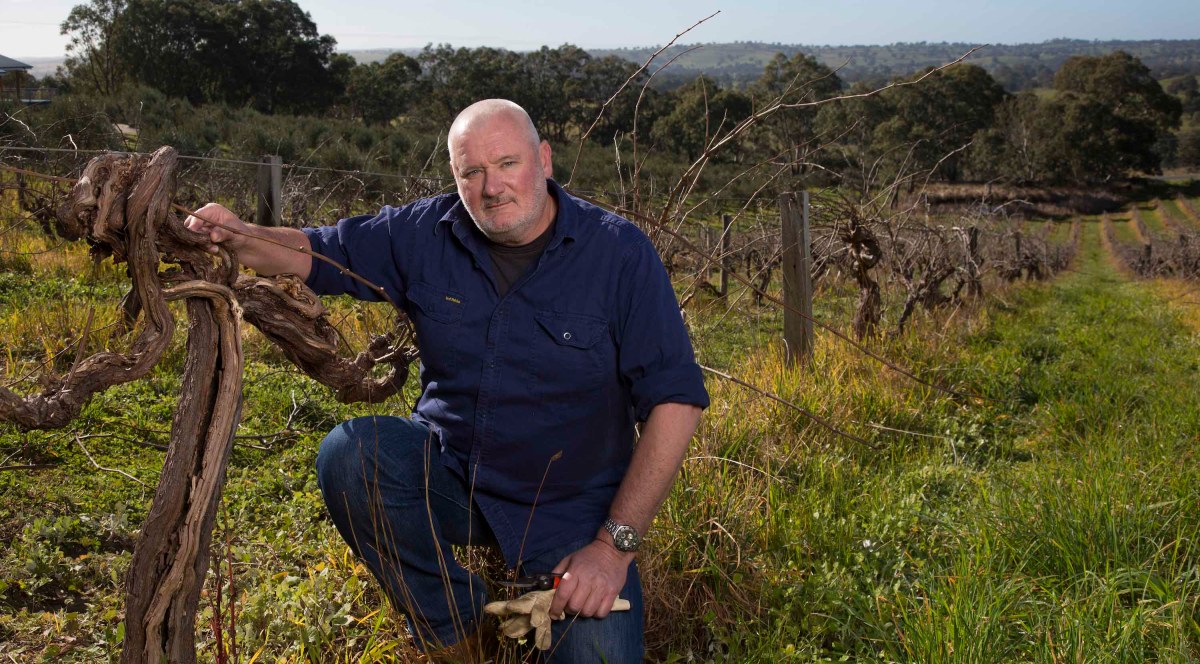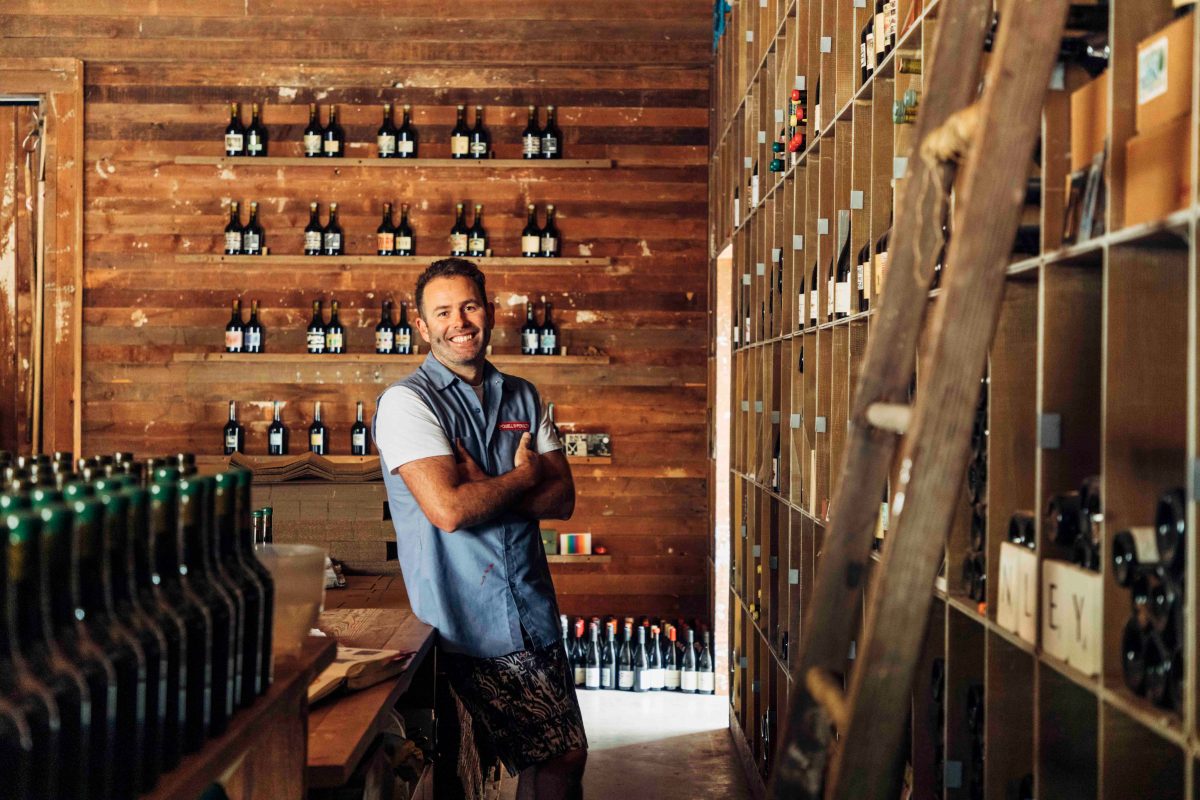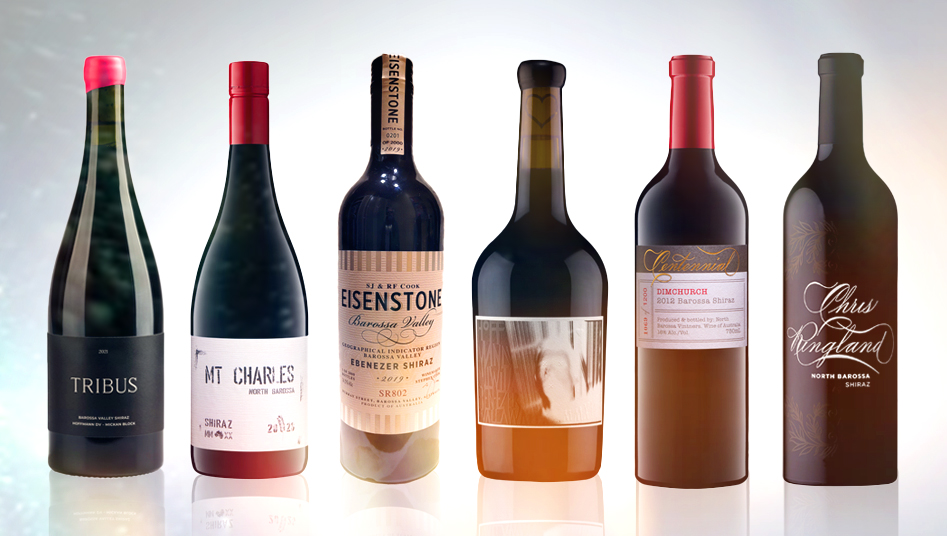Wine reviews: The Barossa’s secret powerhouse
How a tiny corner of South Australia’s most famous wine region hit the big time.


Winemaker and viticulturist Adrian Hoffman in one of his family's north Barossa vineyards. Supplied image
Today we head into parts unknown – a sector of the Barossa Valley most folks would never see.
There aren’t any of those big cellar doors or fancy winery restaurants popular around the towns of Lyndoch, Tanunda, Nuriootpa and Angaston.
Nor is it the home of better-known sub-regional designations such as Greenock, Seppeltsfield, Marananga, Bethany, Krondorf or Rowland Flat.
We’re going into the deep, deep north, beyond the Sturt Highway as it heads across the top of the valley towards Murray River country. And yes, there are some district names here that you might recognize: Moppa, Kalimna and Koonunga, which have given their locations to labels of famous brands over the years.
In here, as well, the valley stretching its arms towards the sun, is the evocatively named district of Ebenezer. It, too, has graced the labels of several famed Barossa Shiraz wines, though the name was dragged into a corporate battle a couple of decades ago over the trademarking of the locality and who could or couldn’t use it.
Despite such ugly dramas, Ebenezer still exists on the map as a place with a strong historic place in the Barossa wine narrative, and remains a source district for many of the region’s most powerful red wines.
Let’s step back in time to briefly colour in that story. Ebenezer was one of the valley floor districts where Lutheran migrants settled in the 1850s, one group establishing a tiny village they called Neukirch, with its church and blacksmith shop surrounded by small farms and devout families. It also happened to be a halfway point between the copper mining centre of Kapunda and the banks and monied dealers in Angaston, so it became a place to swap horses and wagons on the way. For a variety of reasons the village never developed further, though the Lutheran congregation and their farms stayed.
After the First World War, when German place names were wiped from the map, Neukirch became Dimchurch, though the original name was restored in 1975.
One of the settler families was the Hoffmanns, who purchased their property and built a modest slab hut in the late 1850s, setting up a mixed farm that included veggies, orchards, dairy cattle and, from the 1880s, grape vines. That first block is a treasured site within the Hoffmann estate. Known as the Dallwitz Block, it contains vines planted between 1888 and 1912.
Adrian Hoffmann now oversees the business, six generations after his forbears found their way here. He has grown the property to 135 hectares under the broader title of Dimchurch Vineyards, with newer plantings occurring through the 1990s until the 2020s across several separate block names.
In the beginning, the grapes were sold to Benno Seppelt at Seppeltsfield, and over the years went to other big-time producers. Penfolds was a major outlet until the 1990s when the Hoffmanns began to diversify their client list. Rockford took its first load of Ebenezer-grown Shiraz in 1992, an important component of the famed Rockford Basket Press Shiraz, according to its then-vintage winemaker Chris Ringland.
“The Ebenezer fruit was very characteristic and unique in that very traditional big, blackberry chocolatey Shiraz expression,” Ringland recalls.
“It was one of 30 vineyards in Basket Press Shiraz, but its contribution in terms of style and the oak profile it enabled certainly outweighed its proportion in terms of impact in the final wine.”

Chris Ringland first used Ebenezer fruit when he was responsible for the famed Rockford Basket Press Shiraz. Supplied image
The reputation of the Hoffmann’s Ebenezer-grown fruit has only grown since. Now the Hoffmann blocks provide for producers such as Glaetzer, Two Hands, Torbreck, John Duval, Hayes Family Wines, Sami-Odi, First Drop, Soul Growers, The Standish Wine Company, Tomfoolery, Eisenstone and Chris Ringland’s own branded wines.
Several of these, and Adrian Hoffman’s own wines, under the Dimchurch Vineyards label, as well as a couple of other smaller releases called Mt Charles and Tribus, the latter created by a close group of mates, will add to a collection of a dozen big-gun wines being showcased in one of this month’s Barossa Vintage Festival more in-depth tasting events. The tasting will be held in the family’s original barn building at the Dimchurch settlement site.
It’s a rare insight into the way one small place can have such a recognisable footprint. And also how that same dramatic impact on a wine style has played a major role in defining the uniqueness of Barossa Valley Shiraz in the global wine consciousness.
For Adrian Hoffmann, the link between the Ebenezer district footprint and the Hoffmann “brand” of wine is inseparable. He now prefers to identify the area as “North Barossa” to get away from the legal issues surrounding the use of the E-word.
“The North Barossa is quite distinct in what it can deliver,” Hoffmann says.
“We can use the word Ebenezer, but I don’t need to go into the debate. And I think North Barossa has a better story to it, people can understand it – they understand Barossa and they understand North.
“North Barossa is more about the style and the generosity, the length and depth of the wine that comes from here.
“It doesn’t have to be just in the dark fruit flavours. It can also be a generosity in spice and the mouthfeel. I’m about the structure of the wine, and I can see that in the grapes and I see that is what happens also in the bottle.”
Pushed to suggest a sales pitch for his own vineyards he adds: “It’s about creating a generosity within a wine that is unparalleled to anything you see anywhere else. It’s about fruit strength, length on the palate and a wine that has the potential to age beyond decades, beyond my years.”
The remarkable thing is that overarching style and character if present in the whole spectrum of wines made by the winemakers attached to the Hoffmann vineyards.
Fraser McKinley, a much-adored, new-generation stylist with his Sami-Odi brand is one of them. He got to know Adrian and his dad Jeff in the early 2000s when they were delivering grapes to Torbreck, where McKinley was working as a cellar hand. When he decided to try his own hand, Adrian found a tonne of grapes for him from his vineyard, and now that has risen to around 17 tonnes.
“My story with them is much more about me working with them as people and personalities,” McKinley says. “They were very nice to me – I had no agricultural background at the start, and they would answer all the many questions I threw at them.
“When I met them I was sourcing 0.8 of an acre, and they had 108 acres at the time, and these days we source from 2.5 hectares from them and they have 135 hectares now.
“There have always been so many different blocks there that it has been enough to satisfy my curiosity about different fruit and what suits me at the time and what works between us.
“It’s been a pretty delightful relationship over what is over 20 years.”
McKinley’s approach with the Hoffmann fruit is to pick at the lower extremes of the vineyards’ sugar ripeness levels so he doesn’t have to acidify the wine later. Not wanting to add anything to the fruit, he also lets indigenous yeast take on fermentation duties.

Fraser McKinley from Sami-Odi came to the north Barossa fruit at the beginning of his local winemaking adventures. Supplied image
When picked early, Hoffmann says his vineyard’s Shiraz shows more red and blue berried characters, with soft tannins. When picked later, the fruit shows darker, forest fruit notes with dark chocolate complexities, and the tannins are more powerful.
McKinley sees the same about the juices in their early transformation to wine, but something more dramatic then takes over.
“At low sugar levels my wines as juices look quite fine and pretty and light, but when we assess those wines in winter, they already have that blood and thunder power that comes from the red clay out there, regardless of when you picked them,” he says.
“I’ve always found that very interesting – it’s the thumbprint that comes with the property. Whatever I try and do, whether I work with whole clusters and stems and carbonic maceration and pick early, I can still taste the same blocks that Chris Ringland makes from there but picking seven to eight weeks later, and made entirely differently.
“There’s a really solid thumbprint from the vineyard.”
Ringland agrees. “There is a unique vineyard, sub-regional, soil characteristic here.
“As a winemaker, it’s wonderful that different winemakers have different expressions they want to portray, and they can do that, while those grapes and wines carry that vineyard’s signature.”
Ringland works with Adrian Hoffmann and another partner, Nathan Burley, to make several nuanced Shiraz iterations from the Ebenezer blocks. He also makes a North Barossa Shiraz from other growers nearby, while the only other wine he makes is from his own vineyard in the Flaxman Valley district in the cooler, eastern hills of Eden Valley.
The Ebenezer wines all have a well-cast, robust style with unmistakable intense blackberry fruit, dark chocolate and minerally notes, with unashamed French oak influence. They tell the North Barossa story with utmost focus and clarity.
“We consider ourselves a part of the emerging story about the complexity and diversity of the Barossa,” Ringland says.
“We have to tell our part of the story – it’s like Burgundy, where there are so many different little sub-regions in the Barossa.
“We have a role to educate people and (tell) our part of the whole region’s identity.”
The Hoffmann Family Vineyards event is now sold out. The 75th anniversary Barossa Vintage Festival program for April 19-23 can be viewed at barossavintagefestival.com.au
TASTING NOTES
The wines reviewed were all opened and decanted several hours before tasting. They were then re-tasted over several days, and, given their robust styling, all benefited from the airing. Such a response can be an indication of long cellaring potential.

Tribus Shiraz 2021
North Barossa Valley /14.7% / $40
Stylishly labelled in black, with its key information pointing to its Hoffmann Vineyard source, specifically the Mickan Block that is much revered by the fraternity of connected winemakers. Firstly the colour – a magenta/black vibrancy. Eye-catching. The aroma is pure Hoffmann territory: great, dark, ripe Shiraz with oak that allows the fruit front and centre position. Nose and palate in harmony, a sense of freshness even at maximum ripeness, with a minerally feel in the mouth, structurally solid and chewy yet full of energy and palate excitement. Very smartly crafted from start to finish.
Mt Charles Shiraz 2020
North Barossa Valley / 16.1% / $50
Mt Charles is Adrian Hoffmann’s own label as a viticulturist and winemaker. The fruit is from the Becker vineyard owned by Adrian’s sister and brother-in-law and managed by Dimchurch Vineyards. No shirking here: it’s a Shiraz that greets you with a huge shake of the senses, nose-lifting with a meaty, port sauce-like richness while the palate is soaked in fruit ripeness, a turbo-thrust of big oak in behind, and bitter-dark chocolate note also adding to the mouth-filling density. Shiraz in V8, or even V12 mode. The Mt Charles Grenache (2021) also goes big – imagine the power and balance of a shot-put thrower rather than a svelte high-jumper.
Eisenstone Ebenezer Shiraz 2019
North Barossa Valley / 14.5% / $85
Sourced from the Hoffmann Vineyard, made by Stephen Cook, with the Ebenezer sub-region named on the label, each individual bottle is numbered up to the total of 2000 made. It is another big oak, big-shouldered, big-chested Barossan Shiraz in the style that has built the sub-region’s reputation. The Hoffmann footprint of rich, dark blackberry/plum/dark chocolate cannot be denied, while here there is a distinctive tangy burst of fruit as the palate thrust kicks in, followed by a fine weave of tannins to finish. Another classic representative of the site.
Sami-Odi Hoffmann Dallwitz Shiraz 2018
North Barossa Valley / 14.9% / $150 approx
This wine is immediately recognisable in the context of the several wines here from the same property, with the fruit sourced from the oldest vine selections. Once again, no matter what winemaker Fraser McKinley chooses to do in the creation of this wine, it has distinctive, locality-based black berry/dark chocolate sensories, with added crushed stony, minerally suggestions. It smells thick and rich with these, yet drinks with a relaxed ease, fresh, black fruit vitality retained while the mid-palate powers along as expected. Even more engagement follows, with generous black pepper notes in the finish. So much to take in and enjoy, sip by sip. Bravo. (Very few bottles make it to retail, hence the approximate price of those that do.)
Dimchurch Centennial Barossa Shiraz 2012
North Barossa Valley / 16% / $200
A special release celebrating the 100th anniversary of vines planted on the Hoffmann Family Vineyards property in 1912. Vigneron Adrian Hoffmann with winemaking collaborator Chris Ringland have great confidence in the ageing of such muscly Shiraz and with 11 years under its belt now this is all the proof they need: the wine is in fabulous shape. The nose is typical of long, slow-ripening Shiraz, swirling with intense aromas, crushed blue and black berries and baked fruit cake. All of the associated flavours remain concentrated and echo in the mouth, tannins coating like a fine dust storm. It’s big, handsome and maturing with utmost grace.
Chris Ringland North Barossa Shiraz 2017
North Barossa Valley / 17.5% / $50
An outlier here only in the sense that this comes from fruit other than the Hoffmann Vineyard, though several select sources, mates and neighbours, within five kilometres. It’s a Shiraz with Chris Ringland’s full saturation signature – he’s long been a master of this style. It opens with a cranium-filling surge of rich, macerated blackberry that suggests a brandied fruit aromatic as well – heady, to say the least. To imagine how such an introduction might be followed in the palate is almost intimidating, but crikey, it finds its own high-bar level of balance and structure, full grape ripeness with surprising acidity intact, supported by up to four years maturation in 20% new and 80% seasoned oak. Fully loaded with all manner of sensory thrills, it is quite the benchmark for this bold style.




